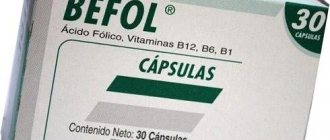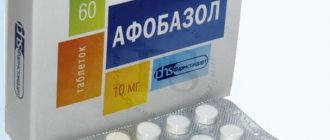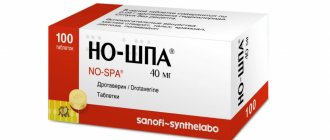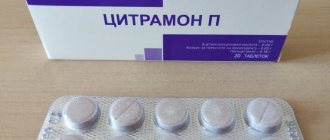Fevarin is an antidepressant with the same mechanism of action as fluoxetine. As you know, the latter is the most used antidepressant on the domestic market. Fevarin has a number of advantages. It is less likely to cause agitation, improves sleep, affects libido to a lesser extent, and has a mild sedative effect. In some countries it has gained wide popularity among doctors and patients.
Compound
Fevarin tablets contain the main active ingredient and auxiliary components. The main active ingredient of fevarin is fluvoxamine - it determines the mechanism of action of the drug, the therapeutic effect and the drug group.
Excipients include mannitol, starch, sodium, silicon, titanium compounds, hypromellose, macrogol and talc. The listed components do not affect the body, but play a role in the absorption of the drug in the gastrointestinal tract.
Pharmacological properties
The mechanism of action of the drug is based on the selective blockade of the re-entry of serotonin into the cell after its release. Normally, serotonin, as one of the mediators of the central nervous system, exits the neuron into the synaptic cleft between cells, binds to the receptors of the neighboring neuron, thus transmits information, and then returns back to its neuron. At the same time, this process occurs with thousands of serotonin molecules.
It has been proven that in people with depression and obsessions, the level of serotonin in brain cells is reduced. Fevarin blocks the entry of this mediator into the cell, moreover, serotonin remains in the synaptic cleft longer and interacts with receptors more times. Systematic intake of fevarin stimulates the synthesis of new serotonin in the neurons of the central nervous system. It takes time to start this process, which explains the delayed effect of the drug.
Thus, this drug increases the concentration of the mediator responsible for good mood, which helps fight depression and other emotional disorders.
In addition, fevarin slightly affects the exchange of two other mood mediators - dopamine and norepinephrine, which causes a number of side effects and contraindications. The drug, unlike many antidepressants, has virtually no effect on the metabolism of acetylcholine, the main mediator of the autonomic nervous system, which makes fevarin a safer medication.
Mechanism of action
Antidepressants affect the functioning of the brain, or more precisely the neurotransmitters of the central nervous system: serotonin, norepinephrine, dopamine, GABA and others.
Antidepressants change the concentration or prolong the action of neurotransmitters. Under their influence, a change in metabolic processes in the brain occurs with the elimination of symptoms of VSD.
They are used to combat such manifestations of vegetative-vascular dystonia as apathy, anxiety, worsening mood, depression, and suicidal thoughts.
It is advisable to prescribe antidepressants in short courses, in small doses only at the beginning of therapy, and then switch to other medications. It is known that long-term use of such drugs changes the balance of benefit and harm towards the appearance of undesirable symptoms.
Interfering with the physiological processes of the body is unsafe. However, the improvement in the condition of those suffering from various forms of vegetative-vascular dystonia as a result of taking these medications confirms their effectiveness.
Antidepressants are part of the main group of medications for the treatment of emotional disorders in patients with autonomic dysfunction.
Indications
The use of fevarin is justified in the following cases:
- Recurrent depressive disorder, mild or moderate episode of depression;
- Single episode of depression;
- Bipolar affective disorder, current episode of depression;
- Decreased mood in old age or with diseases of various organs and systems;
- Obsessive thoughts and/or movements;
- Somatoform and functional disorders in complex treatment.
Fevarin has a mild anti-anxiety effect, so it can be prescribed in cases where depressive or obsessive-compulsive syndrome is accompanied by anxiety, fear, and agitation.
Negrustin for VSD
Combined antidepressant based on St. John's wort. Has anxiolytic, sedative, antidepressant effects. Effective for use in VSD. Due to its mild action, it is less likely to cause adverse reactions.
The product eliminates the following manifestations of VSD:
- panic attacks;
- anxiety;
- obsessive thoughts;
- severe asthenic syndrome (weakness, sleep disturbance, fatigue);
- fear of death;
- excitement against the background of pain of various etiologies.
Among the side effects of Negrustin, allergic manifestations such as itching, redness of the skin, urticaria and photosensitivity are most often observed.
Contraindications
There are a number of conditions for which fevarin cannot be prescribed, as well as conditions that require careful use. Strict contraindications to the use of this drug include:
- Hypersensitivity to any components of the drug. First of all, we are talking about intolerance to fluvoxamine, since this is the main substance. However, a strong reaction to auxiliary components is also a contraindication.
- Bipolar affective disorder, current episode manic. Relatively speaking, mania is an antidepressant, an absolutely opposite direction of affect. Treating her with any antidepressants is contraindicated.
- Concomitant use with monoamine oxidase inhibitors. Combining different groups of antidepressants is contraindicated, since in this case their side effects overlap and intensify. Fluvoxamine can be used no less than 14 days after discontinuation of monoamine oxidase inhibitors. Conversely, after discontinuation of fluvoxamine, MAOIs can be prescribed only after 2 weeks.
In addition to absolute ones, there are a number of relative contraindications. These include:
- Liver and/or renal failure in the stage of decompensation;
- Anamnesis aggravated by cardiovascular diseases, severe atherosclerosis, myocardial infarction, strokes;
- Epilepsy and convulsive syndrome of other etiologies;
- Thrombocytopenic purpura or another cause of decreased platelets in the general blood test, increased bleeding;
- Pregnancy at any stage;
- Childhood.
Pregnancy and childhood are contraindications due to the fact that studies have not been conducted on the appropriate groups of patients. In this case, fevarin can be prescribed if the expected benefit is greater than the possible harm.
Fevarin for VSD
Fevarin is another representative of the SSRIs. It has the same characteristics as its other analogues. The active substance of the drug is fluvoxamine.
This remedy is used only in patients with VSD who note severe manifestations of depression. Common side effects:
- dyspeptic disorders (dry mouth, nausea, loss of appetite);
- worsening emotional lability;
- decreased libido.
The drug is contraindicated in children under 18 years of age, patients who have previously taken MAOI, pregnant women and nursing mothers.
Side effects
Fevarin, like any psychotropic drug, has a fairly large number of side effects. The most common of them include loss of appetite, headache, dizziness, sleep disturbances, both insomnia and drowsiness, nausea, constipation, dry mouth. These symptoms gradually increase as you take the drug, and then disappear on their own with constant use.
In addition, sometimes when taking fevarin there is a decrease or increase in body weight, development or worsening of endocrine metabolic diseases, and increased sweating. Allergic reactions occur quite often, usually manifested by hives and itchy skin. Sometimes neurological disorders develop, most often of an extrapyramidal nature; such patients suffer from tremors of the arms and legs, and changes in handwriting and manner of speaking are possible. Neurological symptoms disappear over time on their own with systematic use of the drug.
In rare cases, fevarin can cause productive psychopathological symptoms - hallucinations, delusions, serotonin syndrome, disorders of consciousness. Cases of pathological bleeding when taking fevarin associated with a decrease in platelet counts have also been described. Particular attention should be paid to this in patients who are prone to thrombocytopenia. Some patients experience sexual dysfunction - decreased libido, erectile dysfunction, anorgasmia, menstrual irregularities.
Cases of the development of akathisia - the inability to maintain a motionless posture - have been described. Such patients constantly move themselves or make stereotypical movements of their limbs. This syndrome occurs in very rare cases with long-term use of large doses of fevarin and goes away after its discontinuation.
Many side effects are observed when using fevarin with other medications. For example, when taking different groups of antidepressants together, or mixing with antihypertensive, antiarrhythmic drugs, antibiotics and cytostatics. You should check with your doctor about the possibility of combination therapy. Another combination that is undesirable in terms of side effects is fevarin and alcohol. You should find out more about this.
Fluoxetine for VSD
Fluoxetine is a representative of the SSRI group. Eliminates symptoms of vegetative-vascular dystonia and panic attacks, relieves anxiety, fear of death, and nervous tension.
Under the influence of Fluoxetine, the severity of peripheral signs of vegetative-vascular dystonia (tachycardia, chest discomfort) decreases. Due to this effect, the medication is often used to treat autonomic dysfunction. The effect of therapy appears after 1-2 weeks of regular use.
Typical adverse reactions during treatment with Fluoxetine:
- weakness;
- headache;
- fast fatiguability;
- unmotivated aggression;
- suicidal thoughts;
- dry mouth;
- loss of appetite;
- nausea;
- decreased sex drive.
The medicine is prescribed by the attending physician. Fluoxetine is contraindicated in patients with individual intolerance to the main component of the drug. It should not be used by pregnant women, nursing mothers, patients with diabetes, people with suicidal tendencies, or epileptic conditions.
Analogues of Fluoxetine include Deprenon, Portal, Prozac and others.
Overdose
There are quite a few cases of fevarin overdose. The most often observed symptoms are from the brain - increased drowsiness, unbearable headache, dizziness, and cases of coma are known. In addition, the cardiovascular system suffers, the development of both bradyarrhythmias and tachyarrhythmias is possible, and a sharp drop in blood pressure is observed. Reflexively, disturbances occur in the digestive system - abdominal pain, diarrhea, nausea, vomiting.
In most cases, an overdose of fevarin is deliberate and can be regarded as an act of suicide. No deaths were observed. The maximum dose of fevarin taken was 12 g, and the patient survived after medical care.
There is no evidence that the cause of suicide is the use of fevarin. Most likely, these actions are associated with the initial condition of the patients and incorrectly selected therapy.
There is no specific antidote for fevarin. If symptoms of overdose appear, you must call an ambulance. Standard detoxification therapy is carried out - gastric lavage, administration of sorbents, infusion therapy of solutions, symptomatic correction of disorders. Such patients are subject to hospitalization in the intensive care unit.
Paxil for VSD
Paxil is an antidepressant with a combined type of action. It blocks the reuptake of 5-hydroxytryptamine, has a slight effect on the metabolism of dopamine, norepinephrine, and serotonin, and has a mild anticholinergic effect.
The drug is often used in the treatment of patients with autonomic dysfunction. It is effective against panic attacks and rarely causes adverse reactions such as dry mouth, vomiting, and diarrhea.
The drug is often used in complex therapy with other medications for vegetative-vascular dystonia.
Paxil quickly eliminates the following symptoms of VSD:
- anxiety;
- emotional lability;
- headaches, dizziness;
- fear of death;
- obsessive thoughts.
The medication intake is agreed with the doctor. Common adverse reactions when taken:
- insomnia;
- decreased libido;
- drowsiness;
- general weakness;
- difficulty ejaculating;
- decreased appetite.
The drug is contraindicated in patients under 18 years of age, pregnant women, and nursing mothers. Paxil is able to dull the feeling of hunger and is used by some patients independently for weight loss, which is unsafe.
Instructions for use
The treatment regimen for fevarin depends on the pathology for which it was prescribed.
When treating depression, the initial dosage is 50 mg per day; if the drug is well tolerated, it is increased to 100 mg per day after about 4 days. After this, once a week you can increase the dosage until the desired result is achieved. The maximum recommended dose is 300 mg. To achieve this, the concentration is increased every week by 50 mg per day. After achieving a therapeutic effect, the drug is used in the achieved dosage until all symptoms of depression are completely relieved. After this, they switch to maintenance therapy. As a rule, it is enough to take 50-100 mg per day for six months.
For the treatment of obsessive-compulsive syndrome, an initial daily dosage of 50 mg is also prescribed, and then 100 mg. These numbers are gradually increased until a maximum of 300 mg is reached. The difference is that most patients require a lower dose of fevarin and a shorter duration of use to treat compulsions. As a rule, after 10 weeks of treatment, the drug can be gradually withdrawn, gradually replacing it with psychotherapeutic help.
If the patient takes 50-150 mg of the drug, a single dose is allowed. For example, in the morning during breakfast. If the dose of fevarin is higher, it is better to switch to a two- or three-time dose. For example, take 150 mg of the drug in the morning and evening, or 100 mg in the morning, lunch and evening.
If you abruptly stop taking fevarin, withdrawal syndrome may develop, which you should learn more about.
Analogs
There are a number of drugs whose main active ingredient is fluvoxamine. Such drugs include:
- Avoxin;
- Luvox;
- Faverine;
- Favoxil;
- Fluvoxamine-Sandoz.
All of the drugs listed are produced by different companies, and therefore have different trade names. They differ in excipients, absorption and distribution in the body. It is not recommended to replace one drug with another.
Reviews
Diana M .: “After divorcing my husband, I had terrible depression, obsessive thoughts and generally felt bad. I wasn’t afraid to go to a psychotherapist who prescribed fevarin. I drank it, gradually increasing the dosage. The first two weeks there were many side effects such as insomnia, nausea, and occasional sweating. Two weeks later everything passed and life began to sparkle with new colors. Now I am very glad that I started taking the drug, I recommend it to everyone, but only after consulting a doctor.”
Ekaterina P .: “Depression hit me completely unexpectedly. It’s just that at one point life began to deteriorate, everything around became gray. My doctor prescribed Fevarin to me; the drug was quite expensive, but I decided to buy it. At first everything was fine, there were no side effects, the product helped me. After about a month or a little earlier, I began to notice that my appearance was changing. When I stepped on the scales, I was simply horrified, there was +15 kg to my weight, I don’t know how I didn’t notice it before. I stopped taking Fevarin and asked to be prescribed another drug, excess weight is a new reason for depression.”
Review from a psychiatrist : “Fevarin is a standard representative of its group of drugs. Selective serotonin reuptake inhibitors are the most commonly used antidepressants. The advantage of fevarin among representatives of this group is its sedative effect. When prescribing other drugs, it is often necessary to supplement therapy with light tranquilizers; when taking fevarin, you can get by with one tablet. The drug is well tolerated.”
Content
Types of antidepressants
There are several types of antidepressants, many of which are used to treat patients with severe symptoms of vegetative-vascular dystonia. They are classified according to their chemical structure and mechanism of action.
Tricyclics (first generation)
The most common drug in the category is Amitriptyline. It is considered a “rough” antidepressant because it affects many processes occurring in the body. Amitriptyline has a pronounced anticholinergic effect: it causes dilation of the pupils, dry mouth, provokes constipation, and urinary retention.
Side effects of the drug sometimes cause serious complications. Since patients often develop dependence on Amitriptyline, doctors compare its effect on a person with the effect of narcotic drugs. Despite this, the drug is very often used to treat vegetative-vascular dystonia, as it reduces gloominess, anxiety, and apathy.
The drug fights depression and stabilizes the emotional background. Amitriptyline therapy should be carried out under mandatory medical supervision to prevent the development of complications. Self-medication is strictly prohibited.
An important feature that determines the popularity of the medicine is its low price. It remains the cheapest “social” antidepressant.
Tetracyclic (second generation)
The drugs of this group differ slightly from Amitriptyline and its derivatives in their chemical structure, but have a more selective effect on the central nervous system.
This explains the less pronounced effect, but also a lower risk of adverse reactions. Typical representatives of this group: Ludiomil, Lerivon (Mianserin), Pyrazidol (reversible MAO inhibitor).
Due to their lower effectiveness, these drugs are not often used in the treatment of vegetative-vascular dystonia or other diseases.
SSRIs (third generation)
A popular category of antidepressants are selective serotonin reuptake inhibitors (SSRIs). They affect only the exchange of the corresponding mediator - serotonin, without interfering with other metabolic reactions. Thanks to this, it is possible to ensure the relative safety of using SSRIs.
Third generation antidepressants are more effective than second generation drugs, but weaker than the first. Adverse reactions occur much less frequently than when using products from the first two categories.
Typical representatives: Rexetine, Citalopram, Cipralex, Fevarin, Zoloft (Sertraline) and others.
SSRIs are often prescribed to patients with VSD. They eliminate symptoms and stabilize the patient’s emotional background.
SSRI (fourth generation)
Selective serotonin and norepinephrine reuptake inhibitors are a combined group of drugs. They are still being studied, so they are rarely used in practice.
The most well-known drugs are Remeron (Mirtazapine) - a tetracyclic antidepressant, Cymbalta (Duloxetine), Milnacipran and others.
The promise of this group of drugs is determined by their effectiveness and a small number of side effects, as with third-generation drugs. However, adverse reactions may be more pronounced at the beginning of treatment.











